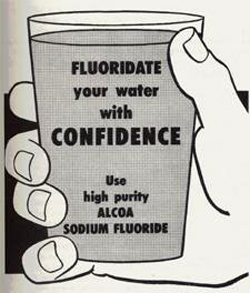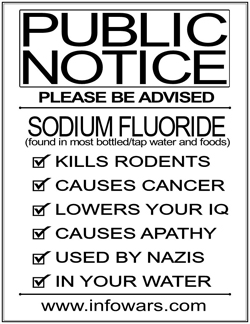Most Americans take it for granted that their public water contains added fluoride.
We drink, cook, and bathe in water with added fluoride, a group of compounds that are composed of naturally occurring fluorine and one or more other elements.
There is ample evidence that shows fluoride works to reduce tooth decay from the outside or “topically” and not from drinking it.
It is the mouth where fluoridated water creates low levels of fluoride in saliva, which reduces the rate at which tooth enamel demineralizes which is what it does in the early stages of cavities.
For decades, the optimal amount of fluoride for fighting cavities – said to reduce them as much as 40% in children – was one part of fluoride for every million parts water (or 1 ppm).
Recently, however, the Niagara Falls Water Board asked for, and received, permission from New York State and local health authorities to reduce fluoride by 20 percent in their tap water from the standard 1 ppm to 0.8 ppm.
The change is based, in part, according to Niagara Falls Water Board Executive Director Paul Drof, on the fact that the old standard of 1 ppm dates back to the 1940’s, and that figure may be obsolete, if not excessive.
Today there are products that provide fluoride that were not available in the 40’s and 50’s when water fluoridation became widespread, Drof explained.
Toothpaste with fluoride was first introduced in the 1970’s.
Drof told the Reporter that he believes future guidelines will seek to establish fluoride levels at 0.8 or 0.7 (ppm). We applied for (a special) reduction and were approved.”
“Fluoride should be added at concentrations that are the least amounts to get continued benefits,” Drof said. “We saw that they would allow us to petition to go below the 1 ppm level to go to 0.8 and we petitioned the local health department and they agreed.”
It was in the 1940s that a study showed that children in a region where water has natural fluoride at levels of 1 ppm or greater had fewer cavities than those who lived where fluoride levels in water were naturally lower.
In 1945, Grand Rapids, Michigan was the first city to add fluoride to its water supply to achieve the 1.0 ppm.
It soon took off in the USA. Fluoridation became an official policy of the U.S. Public Health Service by 1951, and by 1960 water fluoridation reached about 50 million Americans.
By 2006, 61.5% of the U.S. population were receiving fluoridated water.
Water fluoridation is also used in the United Kingdom, Ireland, Canada, and Australia and a handful of other countries. But America is far and away the leader with an estimated 204 million of the world’s 355 million who drink fluoridated water.
Some countries, however, at first followed America then discontinued the practice.
Many European countries, the USSR and Japan abandoned the practice within the last 30 years because it was felt adding fluoride either had no benefits, violated ethical principles of medicating people without their consent or was found harmful to some or many individuals.
There are no European countries that still fluoridate water and these countries have nevertheless experienced declines in tooth decay, a fact many attribute to fluoridated toothpastes.
In addition to the one-half of one percent of the world’s population that receive artificially fluoridated water, about 50 million people worldwide receive water that has natural fluoride in it at levels around 1 ppm. Most rivers and lakes contain fluoride levels of less than 0.5 ppm.
The Niagara River, in samples recently taken under the direction of Niagara Falls Water Board microbiologist Larry Sklarski, showed 0.2 – 0.3 ppm of fluoride, which means that the Water Board is adding between .5 and .7 ppm of fluoride to the water.
Although approved to reduce fluoride down to 0.8 ppm, Drof explained that the Water Board is putting up to 0.9 ppm to achieve a consistent rating of 0.8 throughout its distribution area.
There may be good reason to reduce fluoride levels.
There have been studies linking too much fluoride to cancer, Alzheimer’s, an increased risk of bone fractures, decreased thyroid function, lowered IQ, arthritic-like conditions, dental fluorosis, arthritis, bone cancer, emphysema and the epidemic of attention deficit disorder sweeping America’s children.
And what was once believed to be the minimum, healthy, safe dose of fluoride of 1 ppm is now regarded as the maximum dose. A 1994 World Health Organization committee suggested a level of fluoride of 0.5 ppm is best and the absolute upper bound be 1.0 ppm.
 |
 |
 |
 |
|
Investigative journalist and author of “The Fluoride Deception,” Christopher Bryson claims that, “the post-war campaign to fluoridate drinking water was less a public health innovation than a public relations ploy sponsored by industrial users of fluoride – including the government’s nuclear weapons program.” An advertisement for his book reads in part: “The Fluoride Deception reveals how military and industry scientists and public health officials buried information about fluoride’s potential for human harm, while promoting its use in dentistry… fluoride pollution was the greatest legal threat facing the wartime Manhattan Project. … powerful industries, who all faced extensive litigation for fluoride pollution, collaborated with the Institute of Dental Research to launder fluoride’s image.” |
